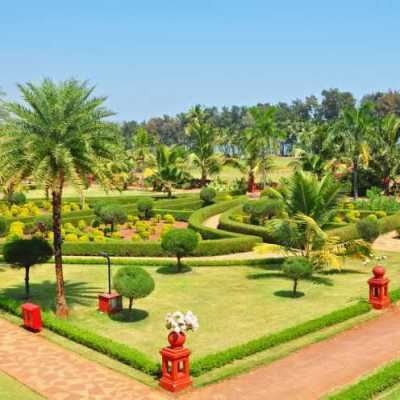Introduction
When one thinks of Goa, pristine beaches, vibrant nightlife, and delicious seafood often come to mind. However, beyond the beaches and parties lies a cultural and spiritual gem – the Mangueshi Temple. Nestled in the heart of this coastal paradise, the temple is not just a religious site but a testament to Goa’s rich history and heritage. In this article, we will embark on a virtual journey to discover the enchanting Goa Mangueshi Temple, exploring its history, architecture, significance, and the spiritual experiences it offers.
Nestled in the heart of Goa, the Mangueshi Temple is a captivating blend of Hindu and Portuguese architectural styles. Dedicated to Lord Shiva, it serves as a sacred place of worship and hosts vibrant annual festivals, making it a must-visit for those seeking spirituality and cultural immersion in this coastal paradise.
A Glimpse into Goa’s History
1. The Origins of Mangueshi Temple
The history of Mangueshi Temple dates back to the 18th century, a time when Goa was under Portuguese rule. The temple is dedicated to Lord Mangueshi, an incarnation of Lord Shiva. It is believed that the deity was relocated from the original site in Kushasthali to its present location in Mangeshi, Ponda, to protect it from the Portuguese inquisition.
2. Architectural Marvel
The temple’s architecture is a blend of Hindu and Portuguese styles, reflecting the cultural amalgamation that Goa has witnessed over the centuries. Intricate woodwork, traditional shikhara, and vibrant frescoes adorn the temple, making it a visual delight for visitors.
Spiritual Significance
3. A Place of Worship
Mangueshi Temple is a sacred place of worship for Hindus in Goa. Devotees from all over the state visit the temple to seek the blessings of Lord Mangueshi. The temple’s serene ambiance and the rhythmic chants create a tranquil atmosphere for prayer and meditation.
4. Annual Festivals
One of the best times to visit the temple is during the annual Shivaratri festival. The temple comes alive with vibrant processions, music, dance, and devotees dressed in traditional attire. It’s a celebration of faith and culture that is not to be missed.
Exploring the Temple Complex
5. Main Shrine
The centerpiece of the temple is the main shrine housing the idol of Lord Mangueshi. The idol is bathed daily in sacred water, milk, and other offerings as part of the daily rituals.
6. Deepastambha
The temple complex also features a Deepastambha or lamp tower. It is a majestic structure adorned with lamps that are lit during special ceremonies and festivals, creating a mesmerizing sight.
Cultural Heritage
7. Preservation of Traditions
Mangueshi Temple stands as a symbol of Goa’s commitment to preserving its traditions. The temple authorities actively promote cultural events and activities, ensuring that the rich heritage of the region is passed down to future generations.
The Spiritual Experience
8. Soulful Chants
The temple resonates with the enchanting sound of devotional songs and chants. Visitors can experience a profound sense of peace and spirituality as they join in these melodic offerings.
9. Prasadam
No visit to the temple is complete without tasting the prasadam, the sacred food offered to the deity. The delicious and traditional Goan prasadam is a treat for the taste buds.

Conclusion
In conclusion, the Mangueshi Temple in Goa is not just a religious site; it’s a testament to the state’s rich history, culture, and spirituality. Visiting this temple is a journey that offers a glimpse into the soul of Goa, taking you beyond the beaches and parties. So, the next time you find yourself in Goa, don’t miss the opportunity to explore the mystical beauty of the Mangueshi Temple.
frequently asked questions about the Mangueshi Temple in Goa:
- What is the historical and religious significance of the Mangueshi Temple in Goa? The Mangueshi Temple is a revered Hindu shrine dedicated to Lord Manguesh, an incarnation of Lord Shiva. It holds immense religious and cultural importance in Goa.
- Where exactly is the Mangueshi Temple situated in Goa, and what are the transportation options to reach there? Located in the village of Mangeshi in Ponda, Goa, the temple is easily accessible by road. Various transportation options are available for reaching this sacred site.
- What are the operating hours of the Mangueshi Temple, and on which days is it open to visitors? The temple welcomes visitors from early morning until late evening every day, providing ample opportunities for devotees and tourists to explore its sanctity.
- Is there a specific dress code or attire that visitors are expected to follow when visiting the temple? To show respect for the sacred space, visitors are kindly requested to dress modestly, avoiding sleeveless attire, shorts, or revealing clothing.
- Can individuals of non-Hindu faiths visit the Mangueshi Temple, and are there any cultural guidelines for their visit? Yes, individuals of all faiths are welcome to visit. It’s important to be respectful of Hindu customs, such as removing shoes before entering the inner sanctum.
- Are there any significant rituals or ceremonies held at the Mangueshi Temple that visitors can witness? Visitors have the opportunity to witness various Hindu rituals and ceremonies, especially during major festivals like Maha Shivaratri and Navaratri, offering a glimpse into the temple’s cultural richness.
- Is there an admission fee to enter the temple, or is it open to the public free of charge? Generally, there is no entry fee, but visitors are encouraged to contribute to the temple’s maintenance through voluntary donations.
- Is photography and videography allowed within the temple premises, and are there any restrictions? While photography and videography are typically permitted in non-restricted areas, it’s advisable to seek permission before capturing images of temple rituals or priests.
- What are the ideal times to visit the Mangueshi Temple to enjoy a peaceful and less crowded experience? The temple is often quieter during the early morning and late evening hours. On weekdays, there tend to be fewer crowds compared to weekends.
- After visiting the Mangueshi Temple, what nearby attractions or points of interest can visitors explore in the surrounding area? Visitors can explore nearby attractions such as the Shantadurga Temple, spice plantations, and the rich cultural heritage of Ponda, enhancing their cultural and spiritual journey.



